The Three Ages by Salvador Daly and the Formal Elements of Art
Salvador Domingo Felipe Jacinto Dali I Domènech (11 May 1904 – 23 January 1989) was a Castilian surrealist artist known for his technical competence, accurate draftsmanship, and his piece of work'southward startling and unusual visuals.
Dali was born in Figueres, Catalonia, Kingdom of spain, and had his official art didactics in Madrid. From an early age, he was influenced by Impressionism and the Renaissance masters, and he grew more interested in Cubism and avant-garde movements.
In the late 1920s, he became more interested in Surrealism and joined the Surrealist group in 1929, rapidly becoming one of its prominent exponents. The Persistence of Retentiveness, his most renowned slice, was created in Baronial 1931 and is 1 of the most famous Surrealist paintings.
Dali spent the Castilian Civil War (1936–1939) in France before moving to the United States in 1940, where he found economic success.
In 1948, he went to Spain, where he declared his render to the Cosmic faith and established his "nuclear mysticism" style, which was inspired by his interests in classicism, mysticism, and modern scientific advancements.
Dali's artistic repertory comprised painting, graphic arts, movie house, sculpture, blueprint, and photography, which he worked on alongside other artists at times. He as well authored poetry, fiction, autobiography, essays, and criticism.
Dreams, the subconscious, sexuality, religion, scientific discipline, and his closest personal connections are all major topics in his writing.
Salvador Dali Virtually Famous Paintings
1. The Persistence of Memory
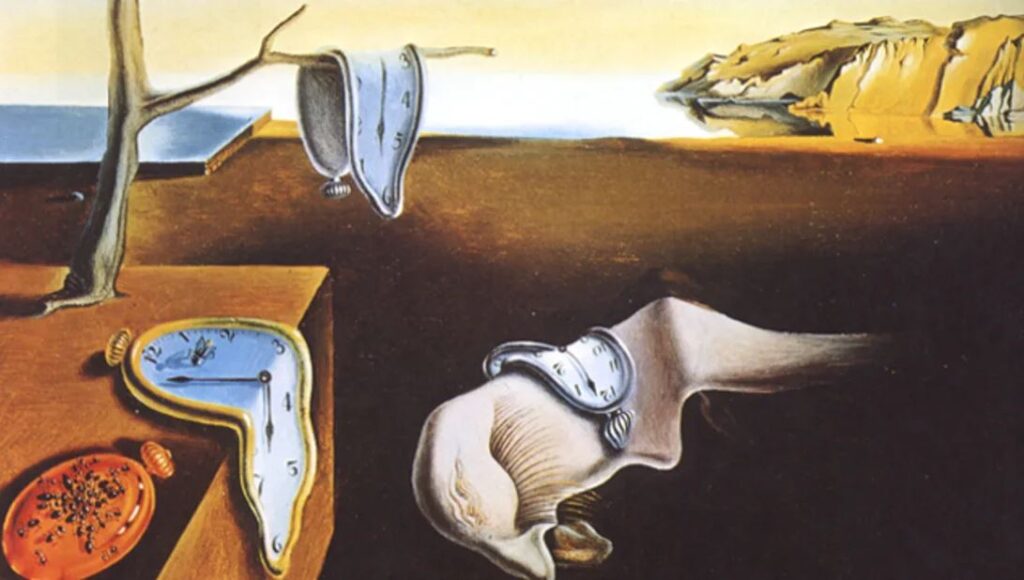
The Persistence of Retention is a 1931 artwork by Salvador Dali that is well recognized every bit a masterpiece of Surrealism.
The artwork was first presented at the Julien Levy Gallery in 1932 and has been in the collection of the Museum of Modern Fine art (MoMA) in New York Urban center since 1934, when it was given to the museum by an unidentified donor.
It is well-known and regularly mentioned in popular civilisation, and is occasionally referred to by more descriptive terms such as "Melting Clocks," "The Soft Watches," or "The Melting Watches."
Dali returned to the theme of this painting with the variation The Disintegration of the Persistence of Memory (1954), which depicted his before famous piece of work systematically fragmenting into smaller component elements, every bit well equally a serial of rectangular blocks that reveal additional imagery through the gaps between them, implying something below the surface of the original work.
The Salvador Dali Museum in Petrograd, Florida shortly houses this piece, whereas the original Persistence of Memory is housed in the Museum of Modern Fine art in New York City.
Tardily in his career, Dali also created lithographs and sculptures based on the concept of soft timepieces. Persistence of Retentivity, Nobility of Time, Profile of Time, and Three Dancing Watches are among the sculptures.
2. Metamorphosis of Narcissus
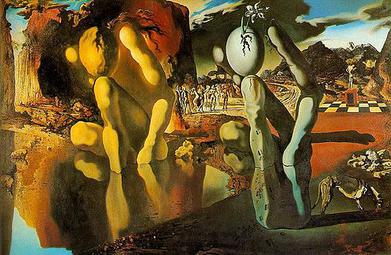
Metamorphosis of Narcissus (1937) is an oil-on-canvas piece of work by Dali that shows his rendition of the Greek fable of Narcissus. Information technology was originally named Métamorphose de Narcisse. Dali started painting in the leap of 1937 in Zürs, Austria, amid the Austrian Alps.
According to Greek mythology, Narcissus' beauty attracted practically everyone who saw him, and both men and women followed him, but he turned downwardly all approaches.
One of his fans, a nymph called Echo, fell passionately in love with him and faded abroad when he rejected her, leaving simply her vox. Taking pity on Repeat, the goddess Nemesis persuaded Narcissus to look into a pool.
Narcissus fell in love with his own reflection later on seeing his own face mirrored in the water. Narcissus faded abroad because he was unable to accept his ain epitome, and in his place sprouted the flower that bears his name, the narcissus.
Dali'southward painting portrays Narcissus crouching past a lake, his head resting on his articulatio genus, and a stone mitt grasping an egg mimicking the contour of his torso on the right.
A narcissus bloom grows from the dissever egg. A group of Narcissus' spurned suitors stands in the painting's center ground. A third Narcissus figure is resting among the mountains in the backdrop.
3. Dream Caused by the Flight of a Bee Effectually a Pomegranate a Second Before Awakening
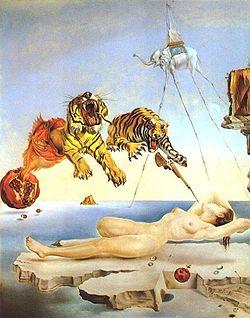
The painting's full title is Dream Caused past the Flight of a Bee Around a Pomegranate a Second Before Awakening, although a shorter variant title is Dream Acquired by the Flying of a Bee.
It was created in 1944, and the lady in the artwork, who seems to exist sleeping, is idea to depict his wife, Gala. The movie is shortly on display in Madrid'due south Thyssen-Bornemisza Museum.
This "hand-painted dream snapshot," as Dali referred to his works, depicts a coastline with vast horizons and tranquil waves, maybe Port Lligat, with Gala as the focus of the image.
Dali displays two suspended drops of water and a pomegranate, a Christian symbol of fertility and resurrection, next to the nude figure of the sleeping lady, which levitates atop a flat rock floating to a higher place the bounding main. A bee, a creature that typically represents the Virgin, hovers above the pomegranate.
In the top left corner of the artwork, what seems to be a yelloweye rockfish breaks out of the pomegranate, spewing along a pouncing tiger preparing to set on Gala and a burglarize with a bayonet about to sting her in the arm.
Above them is Dali's first usage of an elephant with long flamingo legs, which may be seen in subsequent works similar The Temptation of St. Anthony. The elephant holds an obelisk on its back, which was inspired by Bernini'south Elephant and Obelisk in Rome's Piazza Santa Maria sopra Minerva.
4. Lobster Phone

The Lobster Telephone (too known equally the Aphrodisiac Telephone) is a Surrealist artefact designed by Salvador Dali in 1936 for the English poet and surrealist art collector Edward James (1907–1984).
Dali teased in his 1942 book The Hugger-mugger Life of Salvador Dali about why, when he ordered for a grilled lobster at a eatery, he was never given a boiled phone.
The piece is a brew-up of a standard performance telephone with a plaster lobster. It measures roughly 15 30 17 cm (6 12 6.6 inches).
This is a typical Surrealist object, created by combining objects that are non by and large connected with one other, resulting in something both whimsical and scary. Dali thought that such things may expose the unconscious's hidden wants.
Dali associated lobsters and phones with sexual overtones. The telephone occurs in paintings such as Mount Lake from the late 1930s, while the lobster appears in drawings and patterns, oft connected with sensual pleasure and suffering.
5. The Corking Masturbator
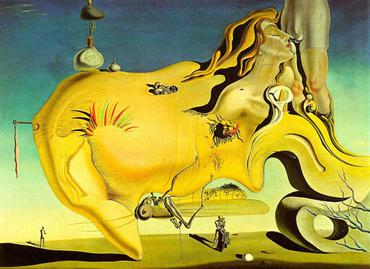
The Groovy Masturbator (1929) is a Salvador Dali artwork from the surrealist era that is presently on exhibit in the Museo Nacional Centro de Arte Reina Sofia in Madrid.
The painting'southward center features a deformed human face in profile facing downwards, based on the shape of a natural rock formation virtually Cap de Creus on Catalonia's seashore.
A similar profile may be establish in Dali's more renowned work, The Persistence of Retentiveness, which was completed two years subsequently.
There have been comparisons to Hieronymus Bosch'south The Garden of Earthly Delights. The Great Masturbator resembles a moving picture on the right side of the left panel of The Garden of Earthly Delights, which is made up of rocks, plants, and small creatures that resemble a face with a large nose and long eyelashes.
Dali retained the picture in his personal collection, which was shown at the Dali Theatre and Museum in Figueres until his death, when it was transferred to the Madrid museum.
half dozen. Swans Reflecting Elephants
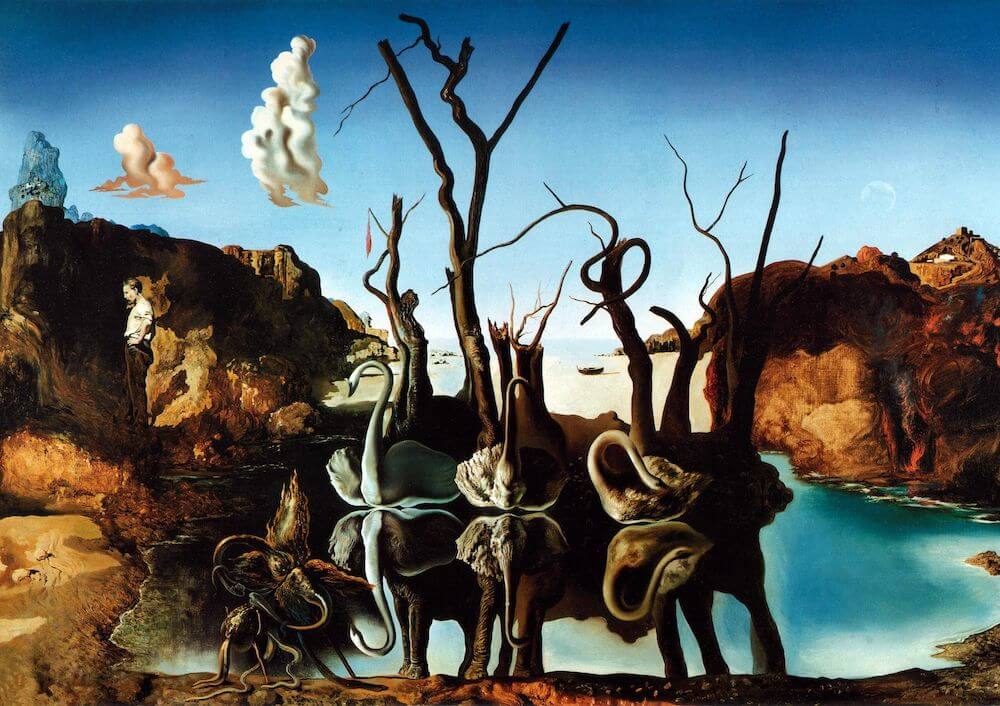
Swans Reflecting Elephants (1937) is a motion picture by Dali during his paranoid-critical era. Information technology is an oil on canvas painting depicting ane of Dali'due south renowned double images. Dali'due south "paranoia-critical technique," which he proposed in his 1935 article "The Conquest of the Irrational," included the utilize of double images.
He described his approach as a "spontaneous way of irrational noesis based on the interpretive critical connection of delirious experiences." Dali employed this technique to create the hallucinogenic shapes, double images, and visual illusions that dominated his paintings throughout the 1930s.
Swans Reflecting Elephants, like the previous Metamorphosis of Narcissus, utilizes a lake's reflection to produce the double image shown in the picture. In Metamorphosis, Narcissus' reflection is employed to mirror the profile of the hand on the right of the image.
The three swans in front end of dismal, leafless copse are mirrored in the lake, such that the swans' necks form elephant trunks, the swans' bodies get elephant ears, and the trees become elephant legs.
7. The Temptation of St. Anthony
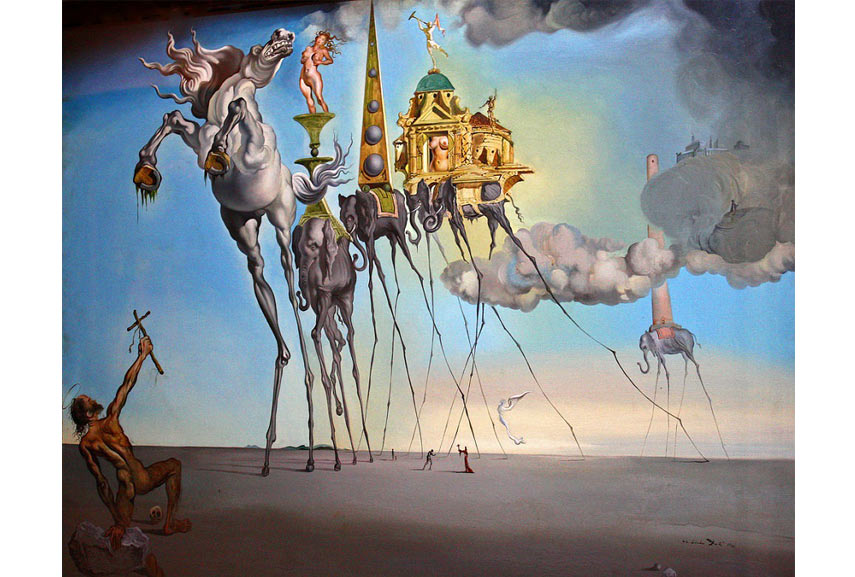
The Temptation of St. Anthony was painted in 1946, and information technology is considered a predecessor to the corpus of Dali'due south work known every bit the "classical phase" or the "Dali Renaissance."
Many surrealistic aspects are included in the artwork, which is characteristic of his work. It was significant since it was the first of his works to show his interest in the intermediaries between Heaven and Globe. The picture is presently housed in Brussels, Belgium, in the Royal Museums of Fine Arts of Belgium.
The title, The Temptation of St. Anthony, hints to the painting's significance and symbolism. Diverse temptations occur to Saint Anthony in this picture (the naked man in the painting). I of them is represented as a horse, symbolizing ability and voluptuousness.
The elephant's shape, carrying on its back the golden cup of passion in which a naked lady stands, accentuates the limerick'south sensual aspect.
The other elephants are carrying structures on their backs; the first is hauling an obelisk inspired by Bernini's in Rome, while the second and third are carrying Palladian-way Venetian edifices.
The animal parade is the painting'southward main point since information technology is the biggest feature, drawing the viewer's attention to temptation.
In the backdrop, another elephant lifts a great construction with phallic connotations, while in the sky, a few parts of the Escorial, a symbol of temporal and spiritual order, can be seen.
Saint Anthony must resist all temptations by using his cantankerous to fend off the vision. The saint appears nude, implying his vulnerability and contrasting it with the force of the cross, which must crush his temptation.
viii. The Elephants
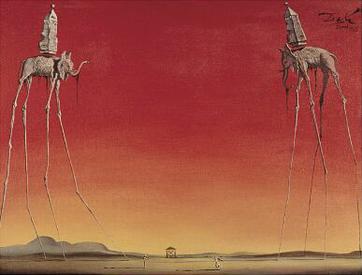
Dali's elephants are a reoccurring topic in his works, showtime appearing in his 1944 slice Dream Caused past the Flight of a Bee Around a Pomegranate a Second Before Enkindling, besides as The Temptation of Saint Anthony and Swans Reflecting Elephants.
The Elephants differs from the other paintings in that the animals are the primary focus of the work, with a barren graduated background and lack of other content, whereas most of Dali'due south paintings contain a not bad bargain of particular and points of interest (for instance, Swans Reflecting Elephants, which is slightly more well-known within Dali's repertoire than The Elephants). The stork-legged elephant is one of Dali's most well-known works.
nine. Christ of Saint John of the Cross
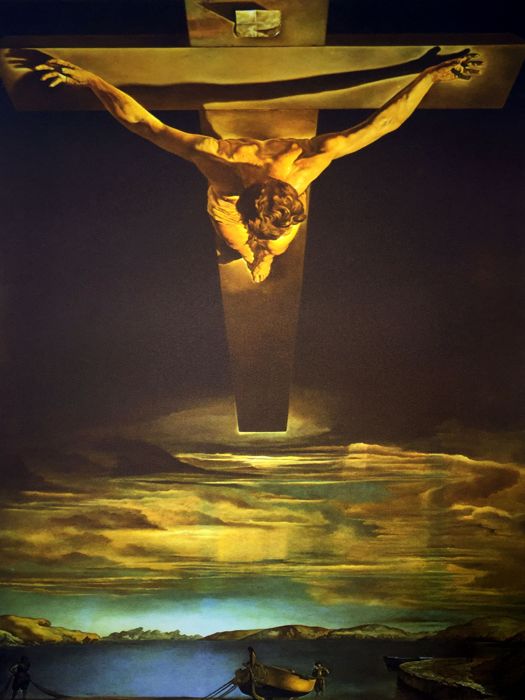
Christ of Saint John of the Cross is a 1951 artwork that is at the Kelvingrove Art Gallery and Museum in Glasgow.
Information technology represents Jesus Christ on the cantankerous floating above a sea under a blackness sky, complete with a gunkhole and fisherman.
Although it depicts the crucifixion, it lacks nails, blood, and a crown of thorns because Dali was persuaded by a dream that these aspects would detract from his representation of Christ.
The significance of presenting Christ at the extreme angle shown in the artwork was also given to him in a dream.
Dali had Hollywood stuntman Russell Saunders hanging from an above gantry to examine how the torso would look from the required perspective and to imagine the force of gravity on the human torso in gild to construct the epitome of Christ. The torso of water represented is the bay of Port Lligat, Dali's home at the time of the painting.
10. The Burning Giraffe
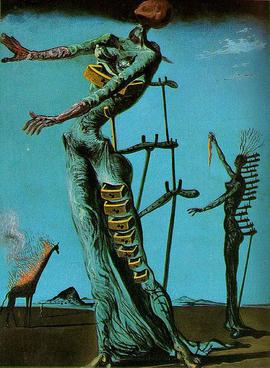
The Burning Giraffe (1937) is an oil painting on panel that is on brandish in the Kunstmuseum Basel.
Before his exile in the United States from 1940 to 1948, Dali painted Burning Giraffe. Although Dali professed himself apolitical ("I am Dali, and but Dali"), this artwork depicts his personal struggle with the conflict in his own country.
A giraffe with its back on burn down can exist seen in the altitude. Dali utilized the burning giraffe motif for the starting time fourth dimension in his 1930 film 50'ge d'Or (The Aureate Age). It reappears in the 1937 painting The Invention of Monsters. This artwork was characterized by Dali as "the macho cosmic apocalyptic monster." He saw it as a sign of impending conflict.
Source: https://www.artst.org/salvador-dali-paintings/
Enregistrer un commentaire for "The Three Ages by Salvador Daly and the Formal Elements of Art"